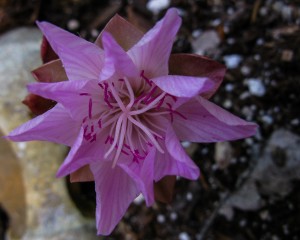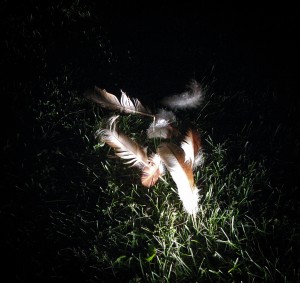Not bear food, not grass,
not each year, but once in ten,
not to be missed
 It is the Bitterroot blooming time in Missoula. Their appearance signals the end of the harvesting season for these roots that were one of the main staples in the Native American diet in the region. The fleshy green shoots of rosettes began appearing on the rocky hillsides around town soon after the snow began to melt, beating out even the earliest flowers. The Native Americans traditionally dug the root in May, before the rosette withers away and the flower blooms, because afterwards the woody brown skin on the root is difficult to remove. Among the Flathead and Kutenai Indians of western Montana, a special ceremony honored the Bitterroot and opened the root and berry picking season. Early settlers reported great gatherings of Flathead, Kalispell, Pend d’Oreille, Spokane and Nez Perce tribes camped in the Missoula valley to collect the roots.
It is the Bitterroot blooming time in Missoula. Their appearance signals the end of the harvesting season for these roots that were one of the main staples in the Native American diet in the region. The fleshy green shoots of rosettes began appearing on the rocky hillsides around town soon after the snow began to melt, beating out even the earliest flowers. The Native Americans traditionally dug the root in May, before the rosette withers away and the flower blooms, because afterwards the woody brown skin on the root is difficult to remove. Among the Flathead and Kutenai Indians of western Montana, a special ceremony honored the Bitterroot and opened the root and berry picking season. Early settlers reported great gatherings of Flathead, Kalispell, Pend d’Oreille, Spokane and Nez Perce tribes camped in the Missoula valley to collect the roots.
Lewis and Clark encountered the plant in the Big Hole Valley in 1805. Captain Lewis tried the boiled roots, finding them quite soft, but complained that they had a bitter, nauseating taste. The first time I tried the Bitterroot I too found them bitter, but I rather liked their astringent taste. Bitters have long been used as a way to stimulate the digestive juices and given the Native American’s meat heavy diet, I imagine that the roots were very beneficial.
Jeff Hart, in his priceless book Montana—Native Plants and Early Peoples recounts one of the origin stories of the plant: “Long ago, as the story goes, in what we now call the Bitterroot Valley, Flathead Indians were experiencing a famine. One old woman had to meat or fish to feed her sons. All they had to eat were shoots of balsamroot, and even these were old and woody. Believing that her sons were slowly starving to death, she went down to the river early one morning to weep alone and sing a death song. The sun, rising above the eastern mountains, heard the woman singing. Taking pity on the old woman, the sun sent a guardian spirit in the form of a red bird to comfort her with food and beauty. The bird flew to the old, gray-haired woman and spoke softly. ‘A new plant will be formed,’ said the bird, ‘from you sorrowful tears which have fallen into the soil. Its flower will have the rose of my wing feathers and the white of your hair. It will have leaves close to the ground. Your people will eat the roots of this plant. Though it will be bitter from your sorrow, it will be good for them. When they see these flowers they will say, here is the silver of mother’s hair upon the ground and rose from the wings of the spirit bird. Our mother’s tears of bitterness have given us food…’”
Even as a twenty first century white woman, when I see the blossoms of the Bitterroot, I feel a deep emotional connection to this mother’s story. But more than that, I am struck by the world view this story illuminates. The idea that the natural world is responsive to us in such an nurturing way is so different from our western view of nature being at best indifferent to us, or, at worst, if it does respond it is always in a violent, revengeful way (you shouldn’t fool with mother nature!) What if nature really is both responsive and benevolent and interconnected to us in such an intimate way? It certainly is worth further exploration and reflection.
 Opening the back door it immediately felt as if something was off. I was late putting the chickens in their coop. In the dark, if not for the moon, I wouldn’t have seen that the gate to their pen was already closed. They had been roaming the backyard freely and the gate was always held open with a bungee cord, but the cord dangled uselessly from the chicken wire. How could the gate have shut on it’s own? Then I remembered my husband had mowed the lawn. He must have forgotten to reopen it after he passed. I knew the chickens wouldn’t have been able to get into the coop to roost, but I headed toward it anyway, hoping to find them milling around outside.
Opening the back door it immediately felt as if something was off. I was late putting the chickens in their coop. In the dark, if not for the moon, I wouldn’t have seen that the gate to their pen was already closed. They had been roaming the backyard freely and the gate was always held open with a bungee cord, but the cord dangled uselessly from the chicken wire. How could the gate have shut on it’s own? Then I remembered my husband had mowed the lawn. He must have forgotten to reopen it after he passed. I knew the chickens wouldn’t have been able to get into the coop to roost, but I headed toward it anyway, hoping to find them milling around outside.
No sign of the chickens. I called to them, rustling the bag of scratch feed, but the yard was eerily still. I searched the grove of ponderosas in the back corner where the chickens liked to browse in tall grass, but that too was empty. Still calling chick, chick, chick I turned toward the bush where they took their dust baths.
A ferocious snarling erupted from the dark cover of the snowberry bushes crowding the back fence–a deep guttural snarling, as if the creature were tearing something apart. My eyes scanned the woods, looking for any sign of movement or even the glow of eyes, but a cloud had crossed the moon and the bushes disappeared into black shadow. I waited, heard the snarl again–close, much too loud to be a raccoon. Definitely not the canine sound of a fox or coyote. Too cat like.
We have never seen a mountain lion in our backwoods, nor any tell- tale prints in the mud or snow, but I have seen dead deer down by the river with their hair shaved off, the way a cat will do. Could a cougar have gotten all three of my chickens? I went to get a flashlight and when I returned I searched every nook and cranny of the yard. At last I heard a very plaintive clucking from behind the garbage can in a corner of the garage and gate. Pulling the can away, I found two of my chickens huddled, one on top of the other, clearly terrified of something. They would not budge and finally I grabbed them, one under each arm, carrying the trembling birds back to the coop and locking them securely inside. Then I went in search of Big Red.
The flashlight beam caught the white shine of fluff, a scattering of tail feathers on the grass. I looked to the snarling bushes, but all was silent and still. Clearly something had been in the yard and chased the terrified chickens. That something must have gotten Big Red.
I love living on the edge of the wild. The sound of coyotes in the backwoods lulls me to sleep and I thrill to see tracks in the forest that tell of my wild neighbors comings and goings. But tonight a line had been crossed. The fence, though it keeps out the deer and protects my fruit trees from their hunger, is not of course enough to keep out a mountain lion. But there was something about the wild coming so close into my home space that discomfited me. Though I knew it was irrational, a primal sort of fear crept into my body and made me toss and turn all night.
The next morning I went out to feed the chickens and there, under the apple tree, Big Red, completely tailless, scratched at the ground for worms. Last night I must have opened the back door just in time for her to escape the cat’s jaws. What then, had the cat been tearing apart? Or was it simply letting me know it’s displeasure in my interruption?